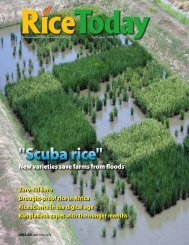How much water does rice need? - adron.sr
How much water does rice need? - adron.sr
How much water does rice need? - adron.sr
You also want an ePaper? Increase the reach of your titles
YUMPU automatically turns print PDFs into web optimized ePapers that Google loves.
Rice on theby Yothin Konbooncutting edgeSometimes the best inventions are accidental. In northeastern Thailand, farmersare adopting a weed-control method first taught to them by their animals.yothin konboonIf performed correctly, thepractice of planting <strong>rice</strong> bybroadcasting <strong>rice</strong> seeds directlyinto unflooded soil offersseveral advantages over the usualpractice of transplanting seedlingsinto flooded fields. Farmers can savetime and labor, less <strong>water</strong> is requiredto establish the crop, and dry directseeded<strong>rice</strong> suffers less from earlyseasondrought. These are importantadvantages, especially in rainfed <strong>rice</strong>,and dry direct seeding is gainingpopularity in a number of areasacross Asia. According to the ThaiOffice of Agricultural Economics,around 38% of rainfed <strong>rice</strong> (reliant onrain with no irrigation infrastructure)in northeasternThailand in 2005was planted todry directseeded<strong>rice</strong>, andthis figure isgrowing.The main problem withdirect-seeded <strong>rice</strong> is weed control.Transplanting seedlings gives <strong>rice</strong>a head start over weeds, and acontinuous layer of <strong>water</strong> suppressesweed growth. In northeasternThailand, the methods used tocontrol weeds differ from placeto place. Some farmers followofficial agriculture departmentrecommendations while othersdevelop their own methods.One of the most promisingfarmer-initiated controls is <strong>rice</strong>cutting, a method first studied in1998 in deep<strong>water</strong> <strong>rice</strong> by Thairesearcher Tawee Kuptkarnjanakul.Because deep<strong>water</strong> <strong>rice</strong> is plantedvery early in the season, the periodbefore flowering is long, resultingin excess growth of leaves andshoots. Farmers would cut theleaves just above the <strong>water</strong> surfaceprimarily to use as animal feed.In northeastern Thailand, <strong>rice</strong>cutting began around 10 years ago,but not as a result of transfer fromdeep<strong>water</strong> <strong>rice</strong> systems. Early-seasondrought is a regular occurrence inthe region and direct-seeded cropsfrequently suffer. When this occurs,some farmers give up on theircrop, leaving it for their animalsto graze. Over the years, farmersCUTTING RICE with aswing grass mower canhelp control weeds.have discovered that, when therains finally resume, the grazedcrop recovers well and ends upyielding a reasonable harvest.After a few years of trial anderror, farmers in different areasdeveloped their own <strong>rice</strong>-cuttingmethods, which all include cuttingdown weeds as well as <strong>rice</strong> earlyin the season. In some places,cutting is done primarily to reduceweed competition; in others, itis to improve soil fertility. Thepractice is spreading throughfarmer-to-farmer communication,media campaigns, and extensionworkers (the people responsiblefor technology dissemination).<strong>How</strong>ever, farmers’ and researchers’understanding of the benefits of <strong>rice</strong>cutting, and the conditions underwhich it succeeds or fails, is stillvery limited. Therefore, Thailand’sUbon Ratchathani Rice ResearchCenter (URRC)—with assistancefrom the Consortium for UnfavorableRice Environments (CURE), agroup of national and internationalinstitutions led by the InternationalRice Research Institute—ha<strong>sr</strong>ecently conducted farm surveysto study and test this technology.Farmers who practice <strong>rice</strong> cuttingsay that it boosts their <strong>rice</strong> yieldssubstantially, with some claimingthat it also improves soil fertility.They tend to use the method withtall, photosensitive <strong>rice</strong> varieties—that is, varieties that flower inOctober independent of the sowingdate—including Thailand’s famousjasmine <strong>rice</strong>. Once the <strong>rice</strong> crop hasbeen established, it is managed asusual until late July–early Augustwhen the <strong>rice</strong> cutting is conducted.This leaves around 50 days before18 Rice Today January-March 2009

















